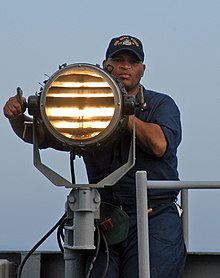
Back Morsekode Afrikaans Codigo Morse AN شفرة مورس Arabic كريپطة د مورس ARY ম'ৰ্চ ক'ড Assamese Códigu morse AST Morze əlifbası Azerbaijani Морзе алфавиты Bashkir Азбука Морзэ Byelorussian Азбука Морзэ BE-X-OLD


Morse code is an old system of encoding messages that is used to send telegraphic information using signals and rhythm. In written communication, Morse code uses dots and dashes to represent a limited number of alphabet letters, numbers, punctuation and special characters of a given message. When messages are sent by sound, radio signals or light flashes, dots are short beeps or clicks or flashes, and dashes are longer ones. For example, Wikipedia written in Morse code is .-- .. -.- .. .--. . -.. .. .-
Morse code is named after Samuel Morse, who helped invent it. It is not used as much today as it was in the 19th and 20th centuries. Teletypewriters were invented in the early 20th century with their own codes and gradually replaced Morse code. Other types of technology that are easier to use for communication became even more common.
Some amateur radio operators still use Morse code to communicate and were previously required to learn and pass telegraphy exams to qualify their licenses. The requirements were lifted after 2003.[1]
There are different types of Morse code for some different countries.
There are three different symbols in Morse code; there's a short one, usually called 'dit', a long one, called 'dah', and the pause. A dah is three times as long as a dit, and the pause has the same length as the dit.
Today, Morse codes can be easily generated through smartphone applications or through a web application, which take text as input and outputs the Morse code in copyable text or downloadable audio form. Its usage as a method of sending secret messages has become obsolete in favor of more powerful encryption techniques provided by advanced modern computer machines.
- ↑ "A Brief History of Amateur Radio | Marin Amateur Radio Society". Retrieved 2020-12-28.
© MMXXIII Rich X Search. We shall prevail. All rights reserved. Rich X Search